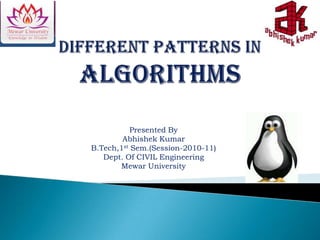
Ak different patterns in algorithms
- 1. Presented By Abhishek Kumar B.Tech,1st Sem.(Session-2010-11) Dept. Of CIVIL Engineering Mewar University
- 2. 1. SEQUENTIAL 2. SELECTIONAL 3. ITERATIONAL
- 3. SEQUENTIAL CONSTRUCTS EXECUTE THE PROGRAM IN THE ORDER IN WHICH THEY APPEAR IN THE PROGRAM.
- 4. ALGORITHM TO CALCULATE PERSENTAGE OF MARKS IN THREE SUBJECTS. STEP 1: START STEP 2:READ MARKS1,MARKS2, MARKS3 STEP3: SUM=MARKS1+MARKS2+MARKS3 STEP4: PERCENTAGE=(SUM*100)/300 STEP5: DISPLAY PERCENTAGE STEP6: STOP
- 5. SELECTIONAL CONSTRUCT CONTRPL THE FLOW OF STATEMENT EXECUTION IN ORDER TO ACHIEVE THE REQUIRED RESULT.
- 6. ALGORITHM TO FIND WHEATHER ANUMBER IS ODD OR EVEN STEP 1: START STEP 2:READ NUMBER STEP3: IF NUMBER%2=0 DISPLAY EVEN ELSE DISPLAY ODD STEP6: STOP
- 7. ITERATIONAL ARE USED WHEN A PART OF THE PROGRAM IS TO BE EXECUTED SEVERAL TIMES.
- 8. ALGORITHM TO PRINT A TABLE OF A NUMBER STEP 1: START STEP 2:READ NUMBER STEP3:COUNTER=1 STEP4: DISPLAY PRODUCT=NUMBER*COUNTER STEP5:COUNTER=COUNTER+1 STEP6:IF (COUNTER<=10) THEN GO TO STEP3 STEP6: STOP
- 9. ALGORITHM TO FIND AVERAGE AND WHEATHER STUDENT IS PASSED OR FAIL FOR N STUDENTS STEP1:START STEP2:READ NUMBER OF STUDENTS STEP3:COUNTER=1 STEP4:READ MARKS1,MARKS2,MARKS3 STEP5:SUM=MARKS1+MARKS2+MARKS3 STEP6:PERCENTAGE=(SUM*100)/300
- 10. STEP7:IF (PERCENTAGE>=65) THEN DISPLAY PASSED ELSE DISPLAY FAIL STEP8:COUNTER=COUNTER+1 STEP9:IF(COUNTER<=NO. OF STUDENTS) THEN GO TO STEP3 STEP10:STOP
